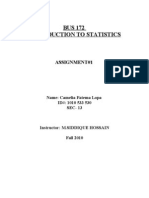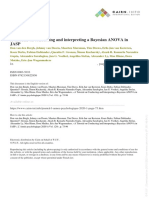Stat 2
Stat 2
Uploaded by
Marie TaylaranCopyright:
Available Formats
Stat 2
Stat 2
Uploaded by
Marie TaylaranOriginal Description:
Copyright
Available Formats
Share this document
Did you find this document useful?
Is this content inappropriate?
Copyright:
Available Formats
Stat 2
Stat 2
Uploaded by
Marie TaylaranCopyright:
Available Formats
Statistics is a vital branch of mathematics that deals with data collection, analysis, interpretation, and
presentation. It is divided into two main branches: Descriptive Statistics and Inferential Statistics.
Descriptive Statistics involves the organization, summarization, and presentation of data in numerical or
graphical form. It provides a summary of the key features of a dataset, such as the mean, median, mode,
variance, and standard deviation. Descriptive Statistics aim to describe and summarize data to identify
patterns and trends, providing valuable insights into a dataset.
On the other hand, Inferential Statistics involves making inferences and generalizations about a
population based on sample data. It uses statistical methods to draw conclusions about a population
parameter, such as a mean or proportion, from a sample statistic. Inferential Statistics helps researchers
make predictions and test hypotheses, enabling them to make informed decisions and draw valid
conclusions based on data analysis. It involves techniques such as hypothesis testing, regression
analysis, and confidence intervals.
Both branches of Statistics play a crucial role in research, decision-making, and problem-solving across
various fields, including business, healthcare, social sciences, and engineering. Descriptive Statistics help
summarize and present data in a meaningful way, while Inferential Statistics allow researchers to make
educated guesses and draw conclusions based on sample data. Researchers can uncover patterns,
relationships, and insights in data by applying statistical methods and techniques, driving evidence-
based decision-making and informed conclusions. Overall, the two branches of Statistics complement
each other, providing a comprehensive approach to data analysis and interpretation.
---
Statistics is a field of study divided into two main branches: descriptive and inferential. Descriptive
statistics involve the collection, organization, and presentation of data to summarize and describe
characteristics of a dataset. This branch of statistics provides valuable information about the central
tendency, dispersion, and shape of the data. On the other hand, inferential statistics involves using
sample data to make inferences or draw conclusions about a larger population. This branch of statistics
allows researchers to test hypotheses, make predictions, and generalize findings to the broader
population. Understanding the differences and applications of these two branches is crucial for
conducting meaningful and reliable research in any field.
You might also like
- IHP 340 Module Six WorksheetDocument3 pagesIHP 340 Module Six WorksheetRobin McFaddenNo ratings yet
- Q1Document11 pagesQ1abdul majeedNo ratings yet
- Math JohnDocument2 pagesMath JohnJenny Rose CabañaNo ratings yet
- Creative and Minimal Portfolio PresentationDocument5 pagesCreative and Minimal Portfolio PresentationWendell Jiro Jr.No ratings yet
- Best Practices ForDocument8 pagesBest Practices FornoureldinfatmaNo ratings yet
- 11 - Descriptive and Inferential Statistics - ThoughtCoDocument3 pages11 - Descriptive and Inferential Statistics - ThoughtCoSaravananNo ratings yet
- Module 1Document6 pagesModule 1Shristy JainNo ratings yet
- Utilization of AssessmentDocument4 pagesUtilization of AssessmentIvy Claris Ba-awa Iquin100% (1)
- Statistical MethodDocument3 pagesStatistical MethodAlia buttNo ratings yet
- What Are Statistics?Document11 pagesWhat Are Statistics?Kimverly Ledda GanadenNo ratings yet
- Stat 1Document1 pageStat 1Marie TaylaranNo ratings yet
- Grey Minimalist Business Project PresentationDocument5 pagesGrey Minimalist Business Project PresentationWendell Jiro Jr.No ratings yet
- CSE 323 (1) Statistics in EducationDocument31 pagesCSE 323 (1) Statistics in Educationolasophy4No ratings yet
- Online ActivityDocument2 pagesOnline ActivityP'ng Fei MunNo ratings yet
- Green Aesthetic Thesis Defense PresentationDocument5 pagesGreen Aesthetic Thesis Defense PresentationWendell Jiro Jr.No ratings yet
- Math ProjDocument3 pagesMath ProjF4rh44nNo ratings yet
- Chapter 1 AND 2-b.s.Document9 pagesChapter 1 AND 2-b.s.yahoshu.pandeyNo ratings yet
- Statistics Theory NotesDocument21 pagesStatistics Theory Notesaanya jainNo ratings yet
- CN 6Document2 pagesCN 6Kathereen Frigillana MolledaNo ratings yet
- Stats TheoryDocument10 pagesStats TheoryRitvik ChauhanNo ratings yet
- Element of Stat - Docx 11111Document12 pagesElement of Stat - Docx 11111kvjlano2No ratings yet
- Chap 1 Introduction To StatisticsDocument6 pagesChap 1 Introduction To StatisticslindaasuraphelNo ratings yet
- Stat FileDocument20 pagesStat Filecamilleescote562No ratings yet
- Nature and Scope of Statistics 01-20-2023Document4 pagesNature and Scope of Statistics 01-20-2023eliahheilmeruNo ratings yet
- Comprehensive Insights Into Descriptive and Inferential Statistics in Data Analysis ResubmissionDocument15 pagesComprehensive Insights Into Descriptive and Inferential Statistics in Data Analysis Resubmissionnamazi.deNo ratings yet
- Introduction To Descriptive StatisticsDocument12 pagesIntroduction To Descriptive StatisticsSurya DuttaNo ratings yet
- PA297-Task1-What Is StatisticsDocument1 pagePA297-Task1-What Is StatisticsLGU UPI MTONo ratings yet
- Statistical Data by Group 1 - Statistic Economics 2Document17 pagesStatistical Data by Group 1 - Statistic Economics 2Akhmad Faisal RifkiNo ratings yet
- Notes-Advanced Statistical Methods For Business Decision MakingDocument69 pagesNotes-Advanced Statistical Methods For Business Decision MakingElyas ShahzadNo ratings yet
- Importance of StatisticsDocument2 pagesImportance of StatisticsAbrar AhmadNo ratings yet
- Intern ReportDocument16 pagesIntern ReportAravind KrishnanNo ratings yet
- Educ 202 Asynchronous Activity 2.0Document2 pagesEduc 202 Asynchronous Activity 2.0Sharicka Anne Veronica TamborNo ratings yet
- Descriptive Sta-WPS OfficeDocument3 pagesDescriptive Sta-WPS OfficeDodonGwapo ArnozaNo ratings yet
- Unit 1 TE HonoursDocument22 pagesUnit 1 TE HonoursMegha PatilNo ratings yet
- Statistic WordDocument7 pagesStatistic WordMC Nocum AlvendiaNo ratings yet
- Advanced Statistics in Quantitative ResearchDocument21 pagesAdvanced Statistics in Quantitative ResearchGESIVER MANAOISNo ratings yet
- Bus 172Document17 pagesBus 172souravsamNo ratings yet
- Bam 212 2023Document116 pagesBam 212 2023israeloladapo17No ratings yet
- STATDocument49 pagesSTATMEL ABANo ratings yet
- Statistical TreatmentDocument7 pagesStatistical TreatmentDoc JoeyNo ratings yet
- Term Paper Work For 400 LevelDocument23 pagesTerm Paper Work For 400 LevelAaron KureNo ratings yet
- Statistics BasicsDocument49 pagesStatistics BasicsMEL ABANo ratings yet
- Cross Sectional AnalysisDocument2 pagesCross Sectional Analysismalijessica907No ratings yet
- Role of Statistics in Data ScienceDocument8 pagesRole of Statistics in Data ScienceKiranbala NongthombamNo ratings yet
- Assignment 3Document31 pagesAssignment 3Daniel CryerNo ratings yet
- Fundamentals of StatisticsDocument10 pagesFundamentals of StatisticsLucky GojeNo ratings yet
- Probability and StatisticsDocument27 pagesProbability and StatisticsTarcisio KamauNo ratings yet
- StatisticsDocument3 pagesStatisticsSahil ShabbirNo ratings yet
- Principles of Statistical AnalysisDocument21 pagesPrinciples of Statistical AnalysisKeithNo ratings yet
- Summarize Topic in StatisticalDocument5 pagesSummarize Topic in StatisticalBanesa AsistioNo ratings yet
- M.sc. StatisticsDocument18 pagesM.sc. StatisticsNageshwar YadavNo ratings yet
- Reflection Paper On Statistics: Descriptive Statistics Is Concerned With The Gathering, Classification andDocument2 pagesReflection Paper On Statistics: Descriptive Statistics Is Concerned With The Gathering, Classification andDevin Leyson RevillaNo ratings yet
- What Exactly Is Data ScienceDocument15 pagesWhat Exactly Is Data Sciences6652565No ratings yet
- StatDocument9 pagesStatAtharbhai JanNo ratings yet
- Definition of Statistics and Branches of StatisticsDocument8 pagesDefinition of Statistics and Branches of Statisticsمحمد حامدNo ratings yet
- Yo FamsDocument33 pagesYo Famsbsd5sqmsm7No ratings yet
- Statistics Notes AngeluxDocument55 pagesStatistics Notes Angeluxkarim saidy mwinyiNo ratings yet
- Probability and Statistics 2022 Hand OutDocument34 pagesProbability and Statistics 2022 Hand Outabelcreed1994No ratings yet
- Introduction To Statistics Hand Out 2022 Alebachew A.Document41 pagesIntroduction To Statistics Hand Out 2022 Alebachew A.abelcreed1994No ratings yet
- Stats QuestionsDocument15 pagesStats QuestionsOm PrakashNo ratings yet
- Cert Womens MonthDocument4 pagesCert Womens MonthMarie TaylaranNo ratings yet
- Cert Womens MonthDocument4 pagesCert Womens MonthMarie TaylaranNo ratings yet
- INSET Working CommitteesDocument2 pagesINSET Working CommitteesMarie TaylaranNo ratings yet
- INSET Topics and QuestionsDocument2 pagesINSET Topics and QuestionsMarie TaylaranNo ratings yet
- Ekp Final CanvassDocument2 pagesEkp Final CanvassMarie TaylaranNo ratings yet
- The Impact of Scientific Management in The 21st CenturyDocument4 pagesThe Impact of Scientific Management in The 21st CenturyMarie TaylaranNo ratings yet
- Good MoralDocument2 pagesGood MoralMarie TaylaranNo ratings yet
- Gilanes June C. Cagbay: Senior High SchoolDocument1 pageGilanes June C. Cagbay: Senior High SchoolMarie TaylaranNo ratings yet
- EKP QuoteDocument2 pagesEKP QuoteMarie TaylaranNo ratings yet
- Ekp Po Additional SuppliesDocument1 pageEkp Po Additional SuppliesMarie TaylaranNo ratings yet
- Program of Works Sample Buga NhsDocument14 pagesProgram of Works Sample Buga NhsMarie TaylaranNo ratings yet
- Drum Cartridge CanvassDocument1 pageDrum Cartridge CanvassMarie TaylaranNo ratings yet
- ApplicationDocument1 pageApplicationMarie TaylaranNo ratings yet
- EKP CanvassDocument2 pagesEKP CanvassMarie TaylaranNo ratings yet
- Group 1 Org and Development FinalDocument84 pagesGroup 1 Org and Development FinalMarie TaylaranNo ratings yet
- LabelDocument1 pageLabelMarie TaylaranNo ratings yet
- 2ND Canvass - EkpDocument1 page2ND Canvass - EkpMarie TaylaranNo ratings yet
- Buga NHS - Supplies For NLCDocument5 pagesBuga NHS - Supplies For NLCMarie TaylaranNo ratings yet
- Untitled Design 4Document10 pagesUntitled Design 4Marie TaylaranNo ratings yet
- SuppliesDocument8 pagesSuppliesMarie TaylaranNo ratings yet
- ChecklistDocument1 pageChecklistMarie TaylaranNo ratings yet
- Untitled DesignDocument15 pagesUntitled DesignMarie TaylaranNo ratings yet
- Group 2 ORGANIZATIONS VISION MISSION AND GOALSfinalDocument53 pagesGroup 2 ORGANIZATIONS VISION MISSION AND GOALSfinalMarie TaylaranNo ratings yet
- An Introduction To T Tests - Definitions, Formula and ExamplesDocument3 pagesAn Introduction To T Tests - Definitions, Formula and ExamplesMarie TaylaranNo ratings yet
- Group 5 - Talent Managenet - Nidalyn P AgsalunaDocument15 pagesGroup 5 - Talent Managenet - Nidalyn P AgsalunaMarie TaylaranNo ratings yet
- Scientific Management TheoryDocument4 pagesScientific Management TheoryMarie TaylaranNo ratings yet
- Group 4McKinsey 7s FrameworkDocument14 pagesGroup 4McKinsey 7s FrameworkMarie TaylaranNo ratings yet
- No SittingDocument1 pageNo SittingMarie TaylaranNo ratings yet
- Understanding Change Management NotesDocument9 pagesUnderstanding Change Management NotesMarie TaylaranNo ratings yet
- Lilliefors TestDocument2 pagesLilliefors TestMamang AjaNo ratings yet
- Practice Problem Set 3Document2 pagesPractice Problem Set 3abhay kumarNo ratings yet
- A Collection of Multiple-Choice Cumulative Questions: Answers Are in RedDocument11 pagesA Collection of Multiple-Choice Cumulative Questions: Answers Are in RedEugene Embalzado Jr.No ratings yet
- OE & HS Subjects For 2020-21 - Ready To PrintDocument122 pagesOE & HS Subjects For 2020-21 - Ready To Printbharath hsNo ratings yet
- Based On The Book by Fan/Yao: Nonlinear Time SeriesDocument79 pagesBased On The Book by Fan/Yao: Nonlinear Time SeriesAnisa AnisaNo ratings yet
- Classroom PDFDocument118 pagesClassroom PDFriya jariwalaNo ratings yet
- Probit Analysis MiniTab - Konsentrasi (LC50)Document3 pagesProbit Analysis MiniTab - Konsentrasi (LC50)Hendra A. HerlambangNo ratings yet
- Pengaruh Gaya Kepemimpinan Dan Supervisi Kepala Ruangan Terhadap Kinerja Perawat Dirumahsakit Nene Mallomo Kabupaten Sidenreng RappangDocument17 pagesPengaruh Gaya Kepemimpinan Dan Supervisi Kepala Ruangan Terhadap Kinerja Perawat Dirumahsakit Nene Mallomo Kabupaten Sidenreng RappangTalia AlipaNo ratings yet
- A Tutorial On Conducting and Interpreting A Bayesian ANOVA in JASPDocument25 pagesA Tutorial On Conducting and Interpreting A Bayesian ANOVA in JASPAniela VizitiuNo ratings yet
- Hoffman2007 Total Error ApproachDocument8 pagesHoffman2007 Total Error ApproachConnieNo ratings yet
- Estimating Long-Run PD, Asset Correlation, and Portfolio Level PD by Vasicek ModelsDocument13 pagesEstimating Long-Run PD, Asset Correlation, and Portfolio Level PD by Vasicek Modelsh_y02No ratings yet
- Beta Calcutaion SPSSDocument3 pagesBeta Calcutaion SPSSGalih Pratama PujiyantoNo ratings yet
- Statistics Note Card Front and BackDocument2 pagesStatistics Note Card Front and BackmaevinwrenNo ratings yet
- ch14 Nonlinear Regression ModelsDocument18 pagesch14 Nonlinear Regression ModelsKhirstina Curry100% (1)
- QUIZDocument41 pagesQUIZValentina Correal RubianoNo ratings yet
- Efektifitas Perbedaan Kompres Hangat Dan Dingin Terhadap Perubahan Suhu Tubuh Pada Anak Di Rsud Dr. M. Yunus BengkuluDocument10 pagesEfektifitas Perbedaan Kompres Hangat Dan Dingin Terhadap Perubahan Suhu Tubuh Pada Anak Di Rsud Dr. M. Yunus BengkuluEen HeryatiNo ratings yet
- Running A T-Test in ExcelDocument3 pagesRunning A T-Test in ExcelKim SolimanNo ratings yet
- Chapter 7 (I) Correlation and Regression Model - Oct21Document23 pagesChapter 7 (I) Correlation and Regression Model - Oct21Nguyễn LyNo ratings yet
- Assignment 6 Olivia RobenDocument11 pagesAssignment 6 Olivia Robenapi-531102318No ratings yet
- Tutorial 5.2Document6 pagesTutorial 5.2Shaira Ann FerrerNo ratings yet
- Assessment of Development Control in SurulereDocument28 pagesAssessment of Development Control in SurulereOgunkan Gbenga DavidNo ratings yet
- TUTORIAL - Chapter 09. Hypothesis Concept - Development of HypothesisDocument16 pagesTUTORIAL - Chapter 09. Hypothesis Concept - Development of HypothesisShaarany A/P Chelliah J20G0755No ratings yet
- Hypothesis Testing Smith-SatterthwaiteDocument1 pageHypothesis Testing Smith-SatterthwaiteLixia D.No ratings yet
- 18MAB303T - Testing Hypothesis - Basics 2023Document25 pages18MAB303T - Testing Hypothesis - Basics 2023JEMINA J (RA2011037010010)No ratings yet
- Chapter 6. Hypothesis TestingDocument49 pagesChapter 6. Hypothesis TestingOnoja Mary oluwafunkeNo ratings yet
- Econ104 Fall2016 SyllabusDocument2 pagesEcon104 Fall2016 SyllabusFuego McFuegoNo ratings yet
- How To Do One-Way ANOVA Using PythonDocument15 pagesHow To Do One-Way ANOVA Using PythonFredrik Nilsson100% (1)
- Hypothesis Melted Ice Presentation in Statistic and ProbabilityDocument13 pagesHypothesis Melted Ice Presentation in Statistic and Probabilitynicolecastillano7No ratings yet
- Financial Econometrics Homework 6Document20 pagesFinancial Econometrics Homework 6Allen Jerry AriesNo ratings yet






















































































































